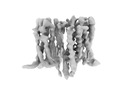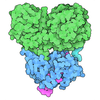+ Open data
Open data
- Basic information
Basic information
| Entry |  | |||||||||
|---|---|---|---|---|---|---|---|---|---|---|
| Title | structure of Ige receptor | |||||||||
 Map data Map data | ||||||||||
 Sample Sample |
| |||||||||
 Keywords Keywords | immunology / Ige receptor / allergy / MEMBRANE PROTEIN | |||||||||
| Function / homology |  Function and homology information Function and homology informationIgE receptor activity / Fc-epsilon receptor I complex / Fc receptor mediated stimulatory signaling pathway / T cell differentiation involved in immune response / high-affinity IgE receptor activity / type I hypersensitivity / Fc-gamma receptor III complex / eosinophil degranulation / neutrophil activation involved in immune response / Fc-gamma receptor signaling pathway ...IgE receptor activity / Fc-epsilon receptor I complex / Fc receptor mediated stimulatory signaling pathway / T cell differentiation involved in immune response / high-affinity IgE receptor activity / type I hypersensitivity / Fc-gamma receptor III complex / eosinophil degranulation / neutrophil activation involved in immune response / Fc-gamma receptor signaling pathway / regulation of platelet activation / Platelet Adhesion to exposed collagen / IgE binding / interleukin-3-mediated signaling pathway / Fc epsilon receptor (FCERI) signaling / IgG binding / type 2 immune response / mast cell degranulation / Dectin-2 family / positive regulation of interleukin-4 production / antigen processing and presentation of exogenous peptide antigen via MHC class I / Fc-epsilon receptor signaling pathway / tertiary granule membrane / immunoglobulin mediated immune response / ficolin-1-rich granule membrane / cellular response to low-density lipoprotein particle stimulus / Role of LAT2/NTAL/LAB on calcium mobilization / positive regulation of phagocytosis / GPVI-mediated activation cascade / neutrophil chemotaxis / FCERI mediated Ca+2 mobilization / Cell surface interactions at the vascular wall / FCERI mediated MAPK activation / antigen processing and presentation of exogenous peptide antigen via MHC class II / receptor internalization / FCERI mediated NF-kB activation / cell surface receptor signaling pathway / defense response to bacterium / immune response / external side of plasma membrane / innate immune response / Neutrophil degranulation / cell surface / protein homodimerization activity / identical protein binding / plasma membrane Similarity search - Function | |||||||||
| Biological species |  Homo sapiens (human) Homo sapiens (human) | |||||||||
| Method | single particle reconstruction / cryo EM / Resolution: 3.9 Å | |||||||||
 Authors Authors | Chen MY / Su Q / Shi YG | |||||||||
| Funding support |  China, 2 items China, 2 items
| |||||||||
 Citation Citation |  Journal: Nature / Year: 2025 Journal: Nature / Year: 2025Title: Molecular mechanism of IgE-mediated FcεRI activation. Authors: Mengying Chen / Qiang Su / Yigong Shi /  Abstract: Allergic diseases affect more than a quarter of individuals in industrialized countries, and are a major public health concern. The high-affinity Fc receptor for immunoglobulin E (FcεRI), which is ...Allergic diseases affect more than a quarter of individuals in industrialized countries, and are a major public health concern. The high-affinity Fc receptor for immunoglobulin E (FcεRI), which is mainly present on mast cells and basophils, has a crucial role in allergic diseases. Monomeric immunoglobulin E (IgE) binding to FcεRI regulates mast cell survival, differentiation and maturation. However, the underlying molecular mechanism remains unclear. Here we demonstrate that prior to IgE binding, FcεRI exists mostly as a homodimer on human mast cell membranes. The structure of human FcεRI confirms the dimeric organization, with each promoter comprising one α subunit, one β subunit and two γ subunits. The transmembrane helices of the α subunits form a layered arrangement with those of the γ and β subunits. The dimeric interface is mediated by a four-helix bundle of the α and γ subunits at the intracellular juxtamembrane region. Cholesterol-like molecules embedded within the transmembrane domain may stabilize the dimeric assembly. Upon IgE binding, the dimeric FcεRI dissociates into two protomers, each of which binds to an IgE molecule. This process elicits transcriptional activation of Egr1, Egr3 and Ccl2 in rat basophils, which can be attenuated by inhibiting the FcεRI dimer-to-monomer transition. Collectively, our study reveals the mechanism of antigen-independent, IgE-mediated FcεRI activation. | |||||||||
| History |
|
- Structure visualization
Structure visualization
| Supplemental images |
|---|
- Downloads & links
Downloads & links
-EMDB archive
| Map data |  emd_39614.map.gz emd_39614.map.gz | 4.2 MB |  EMDB map data format EMDB map data format | |
|---|---|---|---|---|
| Header (meta data) |  emd-39614-v30.xml emd-39614-v30.xml emd-39614.xml emd-39614.xml | 15.5 KB 15.5 KB | Display Display |  EMDB header EMDB header |
| Images |  emd_39614.png emd_39614.png | 35.4 KB | ||
| Filedesc metadata |  emd-39614.cif.gz emd-39614.cif.gz | 5.2 KB | ||
| Others |  emd_39614_half_map_1.map.gz emd_39614_half_map_1.map.gz emd_39614_half_map_2.map.gz emd_39614_half_map_2.map.gz | 7.4 MB 7.4 MB | ||
| Archive directory |  http://ftp.pdbj.org/pub/emdb/structures/EMD-39614 http://ftp.pdbj.org/pub/emdb/structures/EMD-39614 ftp://ftp.pdbj.org/pub/emdb/structures/EMD-39614 ftp://ftp.pdbj.org/pub/emdb/structures/EMD-39614 | HTTPS FTP |
-Validation report
| Summary document |  emd_39614_validation.pdf.gz emd_39614_validation.pdf.gz | 647 KB | Display |  EMDB validaton report EMDB validaton report |
|---|---|---|---|---|
| Full document |  emd_39614_full_validation.pdf.gz emd_39614_full_validation.pdf.gz | 646.5 KB | Display | |
| Data in XML |  emd_39614_validation.xml.gz emd_39614_validation.xml.gz | 8.5 KB | Display | |
| Data in CIF |  emd_39614_validation.cif.gz emd_39614_validation.cif.gz | 10 KB | Display | |
| Arichive directory |  https://ftp.pdbj.org/pub/emdb/validation_reports/EMD-39614 https://ftp.pdbj.org/pub/emdb/validation_reports/EMD-39614 ftp://ftp.pdbj.org/pub/emdb/validation_reports/EMD-39614 ftp://ftp.pdbj.org/pub/emdb/validation_reports/EMD-39614 | HTTPS FTP |
-Related structure data
| Related structure data |  8yvuMC  8ywaC M: atomic model generated by this map C: citing same article ( |
|---|---|
| Similar structure data | Similarity search - Function & homology  F&H Search F&H Search |
- Links
Links
| EMDB pages |  EMDB (EBI/PDBe) / EMDB (EBI/PDBe) /  EMDataResource EMDataResource |
|---|---|
| Related items in Molecule of the Month |
- Map
Map
| File |  Download / File: emd_39614.map.gz / Format: CCP4 / Size: 8 MB / Type: IMAGE STORED AS FLOATING POINT NUMBER (4 BYTES) Download / File: emd_39614.map.gz / Format: CCP4 / Size: 8 MB / Type: IMAGE STORED AS FLOATING POINT NUMBER (4 BYTES) | ||||||||||||||||||||||||||||||||||||
|---|---|---|---|---|---|---|---|---|---|---|---|---|---|---|---|---|---|---|---|---|---|---|---|---|---|---|---|---|---|---|---|---|---|---|---|---|---|
| Projections & slices | Image control
Images are generated by Spider. | ||||||||||||||||||||||||||||||||||||
| Voxel size | X=Y=Z: 1.6305 Å | ||||||||||||||||||||||||||||||||||||
| Density |
| ||||||||||||||||||||||||||||||||||||
| Symmetry | Space group: 1 | ||||||||||||||||||||||||||||||||||||
| Details | EMDB XML:
|
-Supplemental data
-Half map: #2
| File | emd_39614_half_map_1.map | ||||||||||||
|---|---|---|---|---|---|---|---|---|---|---|---|---|---|
| Projections & Slices |
| ||||||||||||
| Density Histograms |
-Half map: #1
| File | emd_39614_half_map_2.map | ||||||||||||
|---|---|---|---|---|---|---|---|---|---|---|---|---|---|
| Projections & Slices |
| ||||||||||||
| Density Histograms |
- Sample components
Sample components
-Entire : Structure of ige receptor
| Entire | Name: Structure of ige receptor |
|---|---|
| Components |
|
-Supramolecule #1: Structure of ige receptor
| Supramolecule | Name: Structure of ige receptor / type: complex / ID: 1 / Parent: 0 / Macromolecule list: #1-#3 |
|---|---|
| Source (natural) | Organism:  Homo sapiens (human) Homo sapiens (human) |
-Macromolecule #1: High affinity immunoglobulin epsilon receptor subunit alpha
| Macromolecule | Name: High affinity immunoglobulin epsilon receptor subunit alpha type: protein_or_peptide / ID: 1 / Number of copies: 2 / Enantiomer: LEVO |
|---|---|
| Source (natural) | Organism:  Homo sapiens (human) Homo sapiens (human) |
| Molecular weight | Theoretical: 4.375302 KDa |
| Recombinant expression | Organism:  Homo sapiens (human) Homo sapiens (human) |
| Sequence | String: KYWLQFFIPL LVVILFAVDT GLFISTQQQV TFLLKIK UniProtKB: High affinity immunoglobulin epsilon receptor subunit alpha |
-Macromolecule #2: High affinity immunoglobulin epsilon receptor subunit beta
| Macromolecule | Name: High affinity immunoglobulin epsilon receptor subunit beta type: protein_or_peptide / ID: 2 / Number of copies: 2 / Enantiomer: LEVO |
|---|---|
| Source (natural) | Organism:  Homo sapiens (human) Homo sapiens (human) |
| Molecular weight | Theoretical: 17.309385 KDa |
| Recombinant expression | Organism:  Homo sapiens (human) Homo sapiens (human) |
| Sequence | String: TWLTVLKKEQ EFLGVTQILT AMICLCFGTV VCSVLDISHI EGDIFSSFKA GYPFWGAIFF SISGMLSIIS ERRNATYLVR GSLGANTAS SIAGGTGITI LIINLKKSLA YIHIHSCQKF FETKCFMASF STEIVVMMLF LTILGLGSAV SLTICGAGEE L UniProtKB: High affinity immunoglobulin epsilon receptor subunit beta |
-Macromolecule #3: High affinity immunoglobulin epsilon receptor subunit gamma
| Macromolecule | Name: High affinity immunoglobulin epsilon receptor subunit gamma type: protein_or_peptide / ID: 3 / Number of copies: 4 / Enantiomer: LEVO |
|---|---|
| Source (natural) | Organism:  Homo sapiens (human) Homo sapiens (human) |
| Molecular weight | Theoretical: 4.552554 KDa |
| Recombinant expression | Organism:  Homo sapiens (human) Homo sapiens (human) |
| Sequence | String: PQLCYILDAI LFLYGIVLTL LYCRLKIQVR KAAITSYEK UniProtKB: High affinity immunoglobulin epsilon receptor subunit gamma |
-Macromolecule #4: CHOLESTEROL
| Macromolecule | Name: CHOLESTEROL / type: ligand / ID: 4 / Number of copies: 2 / Formula: CLR |
|---|---|
| Molecular weight | Theoretical: 386.654 Da |
| Chemical component information |  ChemComp-CLR: |
-Experimental details
-Structure determination
| Method | cryo EM |
|---|---|
 Processing Processing | single particle reconstruction |
| Aggregation state | particle |
- Sample preparation
Sample preparation
| Buffer | pH: 7.5 |
|---|---|
| Vitrification | Cryogen name: ETHANE |
- Electron microscopy
Electron microscopy
| Microscope | FEI TITAN KRIOS |
|---|---|
| Image recording | Film or detector model: GATAN K3 BIOCONTINUUM (6k x 4k) / Average electron dose: 50.0 e/Å2 |
| Electron beam | Acceleration voltage: 300 kV / Electron source:  FIELD EMISSION GUN FIELD EMISSION GUN |
| Electron optics | Illumination mode: FLOOD BEAM / Imaging mode: BRIGHT FIELD / Nominal defocus max: -2.0 µm / Nominal defocus min: -1.2 µm |
| Experimental equipment |  Model: Titan Krios / Image courtesy: FEI Company |
- Image processing
Image processing
| Startup model | Type of model: NONE |
|---|---|
| Final reconstruction | Resolution.type: BY AUTHOR / Resolution: 3.9 Å / Resolution method: FSC 0.143 CUT-OFF / Number images used: 170032 |
| Initial angle assignment | Type: MAXIMUM LIKELIHOOD |
| Final angle assignment | Type: MAXIMUM LIKELIHOOD |
 Movie
Movie Controller
Controller




















 Z (Sec.)
Z (Sec.) Y (Row.)
Y (Row.) X (Col.)
X (Col.)




































